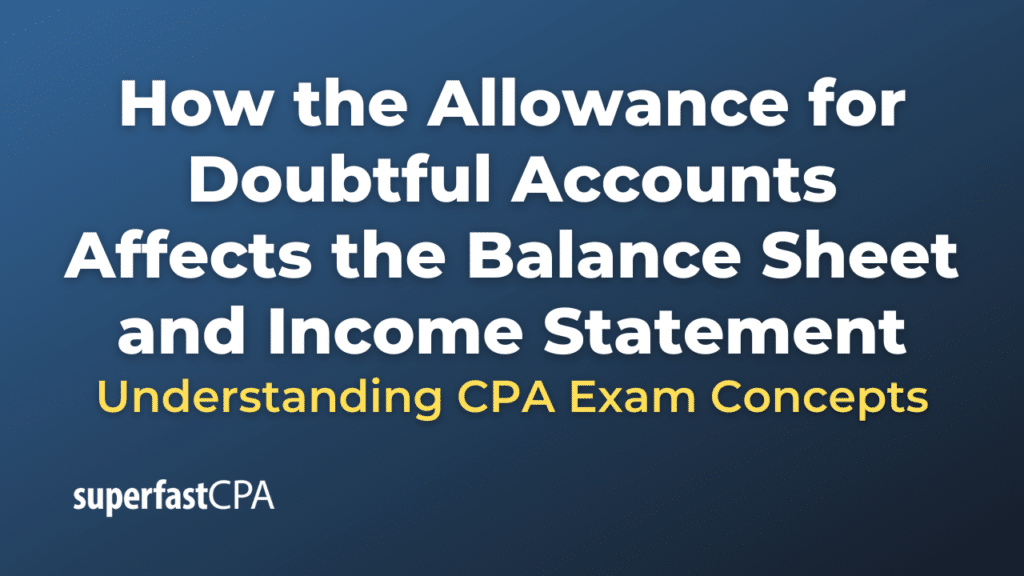Introduction
Explanation of the Allowance for Doubtful Accounts
In this article, we’ll cover how the allowance for doubtful accounts affects the balance sheet and income statement. The Allowance for Doubtful Accounts is a contra-asset account used in accounting to estimate the portion of a company’s receivables that may not be collected. This allowance is a key part of the accrual accounting method, ensuring that a company’s financial statements reflect a realistic view of its financial health. When a business sells goods or services on credit, it records accounts receivable, representing the money owed by customers. However, not all customers will fulfill their payment obligations. To account for this uncertainty, companies set aside an allowance for doubtful accounts, which reduces the gross accounts receivable balance to a more accurate net realizable value.
Importance of Understanding Its Impact on Financial Statements
Understanding the Allowance for Doubtful Accounts is crucial because it directly affects two primary financial statements: the balance sheet and the income statement. On the balance sheet, it provides a more accurate depiction of a company’s current assets by accounting for the potential losses from uncollectible accounts. This adjustment is vital for investors and creditors, as it offers a clearer picture of the company’s liquidity and financial stability. On the income statement, the allowance impacts the reported net income through the bad debt expense, reflecting the cost of credit risk management. Accurate estimation and reporting of this allowance ensure that the financial statements provide a true and fair view of the company’s financial performance and position.
Purpose and Scope of the Article
The purpose of this article is to provide an in-depth understanding of how the Allowance for Doubtful Accounts affects the balance sheet and income statement. We will explore the definition and purpose of this allowance, examine its impact on financial statements, and discuss the common methods used to estimate doubtful accounts. Additionally, we will analyze real-world examples and case studies to illustrate practical applications and highlight industry-specific practices. By the end of this article, readers will gain a comprehensive understanding of the significance of managing and reporting the Allowance for Doubtful Accounts, as well as best practices for ensuring accuracy and compliance in financial reporting.
What is the Allowance for Doubtful Accounts?
Definition and Purpose
The Allowance for Doubtful Accounts, also known as the Allowance for Bad Debts, is a contra-asset account that reduces the total accounts receivable on a company’s balance sheet. It represents the amount of receivables that the company estimates will not be collected due to customer defaults. The purpose of this allowance is to adhere to the accounting principle of conservatism, which ensures that a company’s financial statements present a realistic and cautious view of its financial condition. By anticipating potential losses from uncollectible accounts, the allowance provides a more accurate measure of the net realizable value of receivables, thus enhancing the reliability of financial reporting.
Common Methods for Estimating Doubtful Accounts
Estimating the Allowance for Doubtful Accounts involves predicting the portion of receivables that may not be collected. Two common methods used for this estimation are the Percentage of Sales Method and the Aging of Accounts Receivable Method.
Percentage of Sales Method
The Percentage of Sales Method estimates bad debt expense based on a fixed percentage of total credit sales during a specific period. This method is straightforward and relies on historical data to determine the appropriate percentage. The steps involved are:
- Calculate Total Credit Sales: Determine the total credit sales for the period.
- Apply Percentage: Multiply the total credit sales by the estimated percentage of uncollectible accounts, based on past experience and industry standards.
- Record Bad Debt Expense: The resulting amount is recorded as bad debt expense on the income statement and added to the Allowance for Doubtful Accounts on the balance sheet.
For example, if a company has $100,000 in credit sales and estimates that 2% will be uncollectible, the bad debt expense will be $2,000 ($100,000 * 2%).
Aging of Accounts Receivable Method
The Aging of Accounts Receivable Method provides a more detailed and accurate estimate by categorizing receivables based on the length of time they have been outstanding. This method considers the increased likelihood of non-collection as receivables age. The steps involved are:
- Categorize Receivables: Group accounts receivable into age categories (e.g., 0-30 days, 31-60 days, 61-90 days, and over 90 days past due).
- Apply Estimated Percentages: Assign a percentage of uncollectibility to each age category based on historical data and industry trends.
- Calculate Allowance: Multiply the balance of each category by the respective percentage and sum the results to determine the total allowance.
For instance, if the receivables aging schedule shows $50,000 in the 0-30 days category with a 1% uncollectibility rate, $30,000 in the 31-60 days category with a 5% rate, and $20,000 in the over 90 days category with a 15% rate, the allowance would be calculated as follows:
- 0-30 days: $50,000 * 1% = $500
- 31-60 days: $30,000 * 5% = $1,500
- Over 90 days: $20,000 * 15% = $3,000
- Total Allowance: $500 + $1,500 + $3,000 = $5,000
This method provides a nuanced view of the receivables’ collectibility, ensuring that the allowance reflects the increased risk associated with older receivables.
By using these estimation methods, companies can accurately reflect potential losses from uncollectible accounts, ensuring that their financial statements present a true and fair view of their financial health.
Impact on the Balance Sheet
Description of the Balance Sheet Components
The balance sheet, also known as the statement of financial position, provides a snapshot of a company’s financial condition at a specific point in time. It is divided into three main components:
- Assets: Resources owned by the company that are expected to bring future economic benefits. Assets are typically classified as current or non-current.
- Liabilities: Obligations the company owes to external parties, which are also classified as current or non-current.
- Equity: The residual interest in the assets of the company after deducting liabilities. It represents the ownership interest of shareholders.
How the Allowance for Doubtful Accounts is Reported
The Allowance for Doubtful Accounts is reported on the balance sheet as a contra-asset account, which means it is deducted from the total accounts receivable to reflect the net realizable value of receivables. This presentation ensures that the balance sheet accurately represents the amount of receivables the company expects to collect.
Example of a Balance Sheet with and without the Allowance
Without the Allowance for Doubtful Accounts
| Balance Sheet | Amount |
|---|---|
| Assets | |
| Accounts Receivable | $100,000 |
| Total Current Assets | $100,000 |
| Total Assets | $100,000 |
| Liabilities and Equity | |
| Liabilities | $40,000 |
| Equity | $60,000 |
| Total Liabilities and Equity | $100,000 |
With the Allowance for Doubtful Accounts
| Balance Sheet | Amount |
|---|---|
| Assets | |
| Accounts Receivable | $100,000 |
| Less: Allowance for Doubtful Accounts | ($5,000) |
| Net Accounts Receivable | $95,000 |
| Total Current Assets | $95,000 |
| Total Assets | $95,000 |
| Liabilities and Equity | |
| Liabilities | $40,000 |
| Equity | $55,000 |
| Total Liabilities and Equity | $95,000 |
Effect on Assets (Accounts Receivable and Allowance for Doubtful Accounts)
The Allowance for Doubtful Accounts reduces the gross amount of accounts receivable to present the net realizable value. This adjustment acknowledges that not all receivables will be collected, providing a more accurate picture of the company’s assets. In the example above, the accounts receivable of $100,000 is reduced by the allowance of $5,000, resulting in net accounts receivable of $95,000.
Implications for Financial Health and Liquidity
The Allowance for Doubtful Accounts has significant implications for a company’s financial health and liquidity:
- Accurate Valuation of Assets: By accounting for potential losses, the allowance ensures that the balance sheet reflects a realistic value of the company’s receivables. This accuracy is crucial for stakeholders who rely on the balance sheet to assess the company’s financial health.
- Impact on Liquidity: The reduction in accounts receivable affects the company’s current assets, which in turn impacts liquidity ratios such as the current ratio and quick ratio. These ratios are critical indicators of a company’s ability to meet short-term obligations.
- Investor and Creditor Confidence: Transparent reporting of the allowance for doubtful accounts enhances investor and creditor confidence. It demonstrates prudent financial management and a realistic approach to credit risk, which can positively influence credit ratings and investment decisions.
- Financial Health: A high allowance may indicate significant credit risk, signaling potential issues with customer collections. Conversely, an excessively low allowance might suggest underestimation of credit risk, leading to potential future financial discrepancies.
The Allowance for Doubtful Accounts plays a crucial role in presenting a true and fair view of a company’s financial position. It ensures that the balance sheet accurately reflects the collectibility of receivables, thereby influencing assessments of financial health and liquidity.
Accounting Methods and Estimation Techniques
Detailed Explanation of the Percentage of Sales Method
The Percentage of Sales Method is a straightforward approach used to estimate the Allowance for Doubtful Accounts based on a predetermined percentage of total credit sales. This method relies on historical data and industry averages to determine the appropriate percentage, making it relatively simple to apply.
Steps Involved:
- Calculate Total Credit Sales: Determine the total amount of sales made on credit during a specific period.
- Determine the Percentage: Based on historical data, industry standards, or past experience, establish a percentage that represents the expected uncollectible accounts.
- Calculate Bad Debt Expense: Multiply the total credit sales by the determined percentage to calculate the estimated bad debt expense for the period.
- Record the Expense: The calculated bad debt expense is recorded in the income statement, and the same amount is added to the Allowance for Doubtful Accounts on the balance sheet.
Example:
- If a company has $200,000 in credit sales and estimates that 3% of these sales will be uncollectible, the bad debt expense is calculated as follows:
Bad Debt Expense = $200,000 × 3% = $6,000
The journal entry would be:
- Debit Bad Debt Expense: $6,000
- Credit Allowance for Doubtful Accounts: $6,000
This method is easy to apply and understand, making it suitable for companies with relatively stable and predictable sales patterns.
Detailed Explanation of the Aging of Accounts Receivable Method
The Aging of Accounts Receivable Method offers a more detailed and precise estimation of doubtful accounts by categorizing receivables based on the length of time they have been outstanding. This method acknowledges that the longer an account remains unpaid, the less likely it is to be collected.
Steps Involved:
- Categorize Receivables: Divide the accounts receivable into age categories (e.g., 0-30 days, 31-60 days, 61-90 days, over 90 days past due).
- Determine Percentage for Each Category: Assign a percentage of uncollectibility to each category based on historical data and industry norms.
- Calculate Estimated Uncollectible Amounts: Multiply the amount in each category by the respective percentage to determine the estimated uncollectible amount for each category.
- Sum the Estimates: Add up the uncollectible amounts from all categories to find the total allowance for doubtful accounts.
Example:
Suppose a company’s accounts receivable are categorized as follows:
- $50,000 in the 0-30 days category with a 1% uncollectibility rate
- $30,000 in the 31-60 days category with a 5% uncollectibility rate
- $20,000 in the 61-90 days category with a 10% uncollectibility rate
- $10,000 in the over 90 days category with a 20% uncollectibility rate
The calculations would be:
- 0-30 days: $50,000 ×× 1% = $500
- 31-60 days: $30,000 ×× 5% = $1,500
- 61-90 days: $20,000 ×× 10% = $2,000
- Over 90 days: $10,000 ×× 20% = $2,000
Total estimated uncollectible amount:
$500 + $1,500 + $2,000 + $2,000 = $6,000
The journal entry would be:
- Debit Bad Debt Expense: $6,000
- Credit Allowance for Doubtful Accounts: $6,000
This method provides a more accurate reflection of the collectibility of receivables, especially for companies with diverse customer bases and varying payment behaviors.
Comparison of the Methods and Their Impact on Financial Statements
Percentage of Sales Method:
- Simplicity: Easy to apply and understand, requiring minimal data.
- Consistency: Provides a consistent estimation process based on sales.
- Limitations: May not account for changes in customer behavior or economic conditions affecting collectibility.
Impact on Financial Statements:
- Consistently affects bad debt expense and allowance based on sales, but may not reflect actual collectibility accurately, potentially leading to over or underestimation.
Aging of Accounts Receivable Method:
- Accuracy: Offers a more detailed and precise estimate by considering the age of receivables.
- Responsiveness: Adjusts for changes in customer payment patterns and economic conditions.
- Complexity: Requires more detailed data and analysis.
Impact on Financial Statements:
- Provides a more accurate and realistic view of receivables’ collectibility, leading to more reliable financial statements.
- May result in fluctuating bad debt expense and allowance based on the aging analysis, reflecting actual changes in credit risk.
While the Percentage of Sales Method is simpler and more consistent, the Aging of Accounts Receivable Method provides greater accuracy and responsiveness to changes in receivables’ collectibility. Companies may choose the method that best fits their operations, balancing simplicity and accuracy in their financial reporting.
Real-World Examples and Case Studies
Example from a Real Company’s Financial Statements
To understand how the Allowance for Doubtful Accounts is applied in practice, let’s look at the financial statements of a real company, such as Apple Inc. Apple’s 2023 annual report provides insights into how a large corporation estimates and reports its allowance for doubtful accounts.
In Apple’s balance sheet, you will find the Accounts Receivable line item, which is reported net of the allowance for doubtful accounts. The notes to the financial statements typically provide details on how this allowance is calculated and the assumptions made.
Analysis of How They Report and Manage Doubtful Accounts
Apple Inc. uses a combination of historical loss experience, current economic conditions, and other factors to estimate the allowance for doubtful accounts. Here’s a step-by-step analysis of how Apple manages and reports this allowance:
- Estimation Method: Apple employs the aging of accounts receivable method. They categorize receivables by age and apply historical percentages of uncollectibility to each category.
- Reporting: In the notes to the financial statements, Apple discloses the total amount of accounts receivable, the allowance for doubtful accounts, and the net accounts receivable. This transparency allows investors and stakeholders to understand the assumptions behind the reported figures.
- Management: Apple continually monitors receivables and adjusts the allowance based on new information, such as changes in economic conditions or customer creditworthiness. They also employ robust credit policies and procedures to minimize the risk of bad debts.
Example Data (Hypothetical for Illustrative Purposes):
- Total Accounts Receivable: $15 billion
- Allowance for Doubtful Accounts: $500 million
- Net Accounts Receivable: $14.5 billion
By disclosing these figures, Apple demonstrates its commitment to accurate financial reporting and prudent risk management.
Discussion on Industry-Specific Practices
Different industries have varying practices when it comes to managing and reporting doubtful accounts due to the nature of their business models and customer bases. Here are a few examples:
1. Financial Services Industry:
- High Credit Risk: Banks and financial institutions often deal with high volumes of credit transactions, making the estimation of doubtful accounts critical.
- Regulatory Requirements: They follow stringent regulatory requirements and guidelines, such as those from the Financial Accounting Standards Board (FASB) or International Financial Reporting Standards (IFRS).
- Sophisticated Models: They use advanced statistical models and historical data to estimate credit losses accurately.
2. Retail Industry:
- Frequent Transactions: Retailers deal with a large number of smaller transactions, which can complicate the estimation process.
- Simpler Methods: Many retailers use the percentage of sales method due to the high volume of sales and relatively predictable patterns of customer behavior.
- Seasonal Adjustments: Retailers may adjust their allowances seasonally, considering peak sales periods and corresponding higher credit risks.
3. Technology Industry:
- Diverse Customer Base: Technology companies often have a diverse customer base, including both individual consumers and large enterprises.
- Combination of Methods: They might use a combination of the percentage of sales and aging methods to account for different customer segments.
- Focus on Innovation: As the technology industry evolves rapidly, companies continuously refine their credit policies and estimation techniques to keep pace with changes in the market.
4. Healthcare Industry:
- Billing Complexity: Healthcare providers face complexities in billing and collections due to insurance claims and patient payments.
- Detailed Aging Analysis: They often rely heavily on the aging of accounts receivable method to account for delays in insurance reimbursements and patient payments.
- Regulatory Compliance: Compliance with healthcare regulations also influences their estimation and reporting practices.
While the core principles of managing the Allowance for Doubtful Accounts are consistent across industries, the specific practices and methods can vary significantly. Companies tailor their approaches based on the nature of their business, customer base, and regulatory environment to ensure accurate and reliable financial reporting.
Challenges and Best Practices
Common Challenges in Estimating Doubtful Accounts
Estimating the Allowance for Doubtful Accounts is fraught with challenges, which can significantly impact the accuracy of financial statements. Some common challenges include:
- Economic Fluctuations: Economic downturns or unexpected financial crises can lead to a sudden increase in uncollectible accounts, making it difficult to estimate accurately.
- Customer Creditworthiness: Changes in customer financial health and creditworthiness can be unpredictable, affecting the collectibility of receivables.
- Historical Data Reliability: Relying on historical data may not always provide an accurate forecast, especially in rapidly changing industries or markets.
- Subjectivity in Estimation: The estimation process often involves significant judgment and subjectivity, which can lead to inconsistencies and potential biases.
- Regulatory Changes: Changes in accounting standards or regulatory requirements can necessitate adjustments in estimation methods and reporting practices.
Best Practices for Accuracy and Compliance
To mitigate these challenges and ensure accuracy and compliance in estimating doubtful accounts, companies can adopt the following best practices:
- Regular Review and Adjustment: Periodically review and adjust the allowance based on the latest economic conditions, customer payment trends, and other relevant factors.
- Comprehensive Data Analysis: Utilize a comprehensive analysis of historical data, industry trends, and customer payment behavior to inform estimates.
- Segmentation of Receivables: Segment receivables into different categories based on customer type, age of receivables, and other relevant factors to improve the precision of estimates.
- Use of Advanced Analytical Tools: Employ advanced analytical tools and statistical models to enhance the accuracy of predictions and reduce reliance on subjective judgment.
- Documentation and Transparency: Maintain thorough documentation of the estimation process, including assumptions and methodologies used, to ensure transparency and compliance with accounting standards.
- Training and Development: Invest in regular training and development for accounting personnel to keep them updated on best practices, regulatory changes, and advanced estimation techniques.
Role of Internal Controls and Audits
Internal controls and audits play a critical role in ensuring the reliability and accuracy of the Allowance for Doubtful Accounts estimation process:
- Internal Controls:
- Establishment of Policies: Implement robust credit policies and procedures to govern the estimation and management of doubtful accounts.
- Segregation of Duties: Ensure segregation of duties to prevent conflicts of interest and enhance the objectivity of the estimation process.
- Monitoring and Reporting: Continuously monitor receivables and report on the adequacy of the allowance, adjusting as necessary to reflect current conditions.
- Internal Audits:
- Regular Audits: Conduct regular internal audits to evaluate the effectiveness of the estimation process, internal controls, and compliance with accounting standards.
- Risk Assessment: Identify and assess risks associated with receivables and the estimation process, and recommend improvements to mitigate these risks.
- Audit Trails: Maintain comprehensive audit trails to provide transparency and accountability in the estimation and reporting process.
- External Audits:
- Independent Verification: Engage external auditors to independently verify the accuracy and adequacy of the Allowance for Doubtful Accounts.
- Compliance Review: Ensure compliance with relevant accounting standards and regulatory requirements through external audit reviews.
- Recommendations for Improvement: Utilize external audit findings to identify areas for improvement and implement recommended changes to enhance accuracy and reliability.
While estimating doubtful accounts presents several challenges, adopting best practices and leveraging robust internal controls and audits can significantly enhance the accuracy and reliability of financial reporting. Companies that prioritize transparency, thorough analysis, and continuous improvement are better positioned to manage credit risk effectively and maintain the trust of stakeholders.
Conclusion
Recap of Key Points
In this article, we explored the Allowance for Doubtful Accounts, an essential component in accounting for receivables. We covered:
- Definition and Purpose: The allowance is a contra-asset account that estimates uncollectible receivables to present a realistic view of a company’s financial position.
- Impact on Financial Statements: It affects both the balance sheet and the income statement, providing more accurate valuations of assets and net income.
- Estimation Methods: The two primary methods, the Percentage of Sales Method and the Aging of Accounts Receivable Method, each offer distinct advantages and challenges.
- Real-World Applications: Examples from companies like Apple Inc. illustrate practical applications, while industry-specific practices highlight the diversity in approaches.
- Challenges and Best Practices: We discussed common challenges in estimating doubtful accounts and outlined best practices and the role of internal controls and audits in ensuring accuracy and compliance.
The Importance of Proper Management of the Allowance for Doubtful Accounts
Proper management of the Allowance for Doubtful Accounts is crucial for several reasons:
- Accuracy in Financial Reporting: Accurate estimation and reporting ensure that financial statements reflect the true financial health of a company, providing reliable information for investors, creditors, and other stakeholders.
- Credit Risk Management: A well-managed allowance indicates effective credit risk management, helping companies anticipate potential losses and make informed decisions about extending credit.
- Regulatory Compliance: Adhering to accounting standards and regulatory requirements helps maintain compliance, avoiding potential legal and financial penalties.
- Stakeholder Confidence: Transparent and prudent management of doubtful accounts fosters trust and confidence among investors, creditors, and business partners.
Final Thoughts on Its Impact on Financial Statements
The Allowance for Doubtful Accounts plays a pivotal role in ensuring that a company’s financial statements present an accurate and fair view of its financial position. By accounting for potential losses from uncollectible receivables, companies can provide a more realistic valuation of their assets, which is critical for effective financial analysis and decision-making. Furthermore, the estimation methods and management practices adopted for this allowance reflect a company’s approach to risk management and financial prudence.
In conclusion, the Allowance for Doubtful Accounts is not just an accounting requirement but a strategic tool that helps companies manage credit risk, maintain financial stability, and uphold the integrity of their financial reporting. Proper management and accurate estimation are essential for sustaining stakeholder trust and ensuring long-term financial success.
References and Further Reading
List of Sources and References Used
- Financial Accounting Standards Board (FASB) – For detailed guidelines and standards on the Allowance for Doubtful Accounts, refer to the official FASB website: FASB Standards
- Apple Inc. Annual Report 2023 – For an example of real-world application and reporting of the allowance for doubtful accounts: Apple Inc. 2023 Annual Report
- International Financial Reporting Standards (IFRS) – For global standards and practices related to financial reporting and the Allowance for Doubtful Accounts: IFRS Standards
- Accounting Tools – For practical explanations and examples of the methods used to estimate doubtful accounts: Accounting Tools: Allowance for Doubtful Accounts
- Investopedia – For definitions and insights into financial terms and concepts related to doubtful accounts: Investopedia: Allowance for Doubtful Accounts
Additional Resources for Readers to Explore
- “Financial Accounting: An Integrated Approach” by Ken Trotman and Michael Gibbins – This textbook provides a comprehensive overview of financial accounting principles, including the management of doubtful accounts.
- “Intermediate Accounting” by Donald E. Kieso, Jerry J. Weygandt, and Terry D. Warfield – This book offers an in-depth exploration of accounting standards and practices, including detailed discussions on the allowance for doubtful accounts.
- American Institute of CPAs (AICPA) – For resources, articles, and updates on accounting practices and standards: AICPA Resources
- “Accounting for Dummies” by John A. Tracy – A user-friendly guide that simplifies complex accounting concepts, including how to handle doubtful accounts.
- Coursera: Financial Accounting Courses – Online courses that offer a practical approach to understanding financial accounting, including the estimation and reporting of doubtful accounts: Coursera Financial Accounting Courses
- Harvard Business Review (HBR) Articles – For insightful articles on financial management and accounting practices: HBR Financial Management
These references and additional resources will help readers deepen their understanding of the Allowance for Doubtful Accounts and its impact on financial statements, providing both theoretical knowledge and practical applications.













